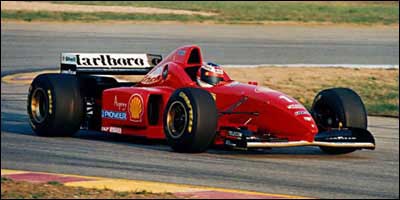|
Ferrari F310 Technical Review |
||||||
Some
tens of Ferrari fans on a main tribune of Estoril, where in middle of
December, 1996 drove test arrivals of several Formula One teams, hardly
have not missed "their" pilot. Some car still latent by a
building of boxes came nearer to last turn of a circuit. But by the
sound of its engine it was Benetton or Williams. Any true fan for a mile
will distinguish shrill howl of 12-cylinder Ferrari from a reference
voice of French V10. Through some instants the car drove out on a
straight line, and the fans of an Italian command have stiffened in
amazement - Ferrari!
Model
F310 (3 liters, 10 cylinders) is the forty-second Formula One car
launched in Maranello. And the first one equipped with the 10-cylinder
V-figurative engine. Apparently, having despaired to overcome the rivals
through the 12-cylinder scheme, which one has selected by Enzo Ferrari
almost half-centuries back, the engineers from Maranello have decided to
take advantage of their own weapons. The
engine, designed by Osamu Goto and Paolo Martinelli, became very mild
and compact. He is 70 mms shorter and 12 kgs lighter than the
forerunner, that opens a wide area for an optimum distribution of
weight and improvement of a controllability. But Goto and Martinelli
have not limited themselves with the reasons of "economies".
The 1995 Ferrari engine reached a bench of 760 h.p. and 17000 rpm. And
the Renault specialists managed to reach 16 thousand rpm. In an agility
of a motor the Ferrari designers saw their main reserve. With this
purpose they transferred themselves to the four-valve scheme
(sacrificing the best filling of cylinders with the fuel to the reduced
weight of moving parts). Besides parts of a valve mechanism were made of
ultra-low and strong alloy. Thus it was possible to reach the speed of
opening/closing of valves of 26,7 m\s (instead of 24 m\s for V12 1995).
It is supposed, that it'll be possible to reach 18 thousand rpm with the
new V10 engine. But about the ultimate output of an engine Italian
engineers are prefer to keep the silence - "more than 600 h.p.". The
body of the car too has undergone essential changes. A massive
"collar of safety", again slightly raised front part, a lateral
air intakes recalling a jet fighter, new design of a back wing - it all
together makes a sinful picture.
A
new car was designed in FDD (Ferrari Design and Development) in an
English city of Gilford, where 38 engineers work under the direction of
one of the masters of the modern Formula One John Barnard. The
half-sized model of the F310 was tested in an aerodynamic tunnel in
Bristol. In
the other parts the Ferrari design has changed not so considerably. The
gearbox is made anew, but it represents only next modification of the
6-stepwise aggregate with transversal arrangement of arbors for the
first time appeared in 1994. The third shock-absorber was added in the
front suspension, as well as for Tyrrell, Williams and Benetton. As
has shown a 1996 season, a new Maranello's stallions are capable to run
by wanton gait. This model has marked the revival of a Pransing Horse
from ashes... |
||||||
| back | ||||||


